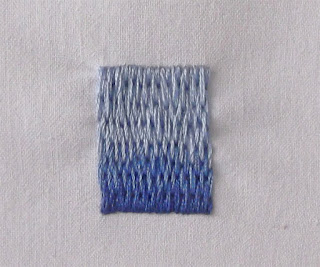The long & short stitch is also referred to as silk shading. long and short shading or needlepainting. Technically, it is a type of satin stitch used to fill shapes like flower petals, leafs, etc. It can be worked in a single color or with multiple colors to achieve a gradient & subtle shading. It is also used if you want to move from one color to another or from a dark shade to a lighter, blending smoothly the colors together. Long & short stitch, in comparison to satin stitch, is a better choice for filling larger areas, because in large areas satin stitch results in loose or puckered stitches. Because, the interlope with each other, the technique is ideal to shading and give a realistic painted finish.
Instructions
1. Start your thread in the bottom left corner of the shape, through point (1).
2. Pass your needle back, a few millimeters up, through point (2) making a small vertical stitch.
3. Bring the needle from back to front, at the bottom of the shape, through point (3) just to the right of the previous stitch and as close as possible.
4. Bring the needle back through point (4) making a vertical stitch twice the length of the first stitch.

5. Continue in this way, alternating long and short stitches, until the base of the square is covered.
6. Start a new row. Bring the needle from back to front through point (a). It is better to work from top to bottom than the opposite to avoid destroying previous stitches. You can choose thread of a different shade.
7. Bring the needle back through point (b) piercing the top of the first stitch. You simply add a long stitch above the first short stitch.
8. Bring the needle from back to front, through point (c).
9. Bring the needle back, piercing the top of the short stitch, adding another long stitch to the row. Note, that in the second row you need to make only long stitches.
10. Continue adding stitches in this manner until the row is completed.
11. Continue adding more rows until you fill the shape.
Note, that it is only in the first and last rows that you actually do long and short stitches. The in-between stitches are all long.
How to stitch the last row.
You have two options. Either to stitch a last row with long & short stitches or to add only short stitches. It depends on the area left to fill.
Long and short stitches are stitched in any direction, vertically, horizontally and even slanted.












No comments:
Post a Comment